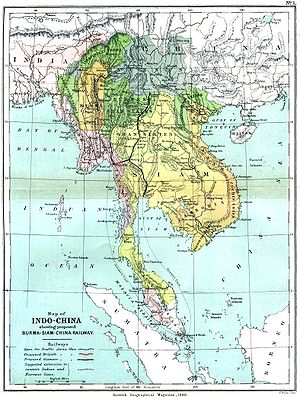 |
| Indochina: aptly named, not clearly defined. |
I feel like its time to delve into the details of Indochina's history, location, and demographics. But first, an exploration in etymology. This is what I found for the origin of the word Indochina, from the Online Etymology Dictionary:
"1886, from Indo-, comb. form of Gk. Indos "India" + China. Name proposed early 19c. by Scottish poet and orientalist John Leyden, who lived and worked in India from 1803 till his death at 35 in 1811."
I think the late Leyden was not so much reflecting on the region's proximity to India and China. Rather, his poet's soul may have recognized the historical influence on the region by the two dominant adjacent civilizations. Much of their influence remains to this day. From the west, the Indian kingdom introduced Buddhism to all three nations, scripts based on Sanskrit to Laos and Cambodia, and Hindu temple architecture featured in places like Angkor Wat in Cambodia. And the eastern contribution, mostly adopted by Vietnam, includes Chinese script and vocabulary, architecture, and world-views such as Taoism and Confucianism, the latter of which shaped Vietnam's social, political, and moral standards.
Leyden was not, and could not have been referring to the unified Southeast Asian territories of the French Empire known as French Indochina. He was long beyond this world when the French colonized Laos, Cambodia and Vietnam between 1858 and 1893 (1).
It seems the "conquistador's trinity"--gold, glory, and God--was at the core of the occupation. Catholic missionaries have ramped up efforts to save souls in SE Asia since Father Alexander De Rhodes started fussing around with the Vietnamese written language in the 17th century. Incidentally, De Rhodes's Romanization of the Vietnamese language marked the beginning of the end for both traditional Vietnamese and Chinese scripts in everyday usage. Another reason for French interest, the Indochinese region produced the kinds of commodities that enticed the European market, commodities like coffee, tea, wood, and labor. As my brother says, Vietnam is rich in resources, so it's a small wonder why a European power would want to claim it. Glory, well, that goes to the victorious.
So the French took over the three countries by seizing Vietnam by force, granting Cambodia protection, and receiving Laos by cession from Thailand. Occupation didn't sit well with Vietnam, and for years France was met by hostile Vietnamese resistance. The Japanese took over the region during World War II, and gave it back to France afterward. France maintained a tenuous grip on the region until it gave up possession as part of the Geneva Convention in 1954. That was the end of French Indochina. The region has been known as Indochina ever since.
Where is it?
There doesn't seem to be a consensus on what Indochina is. The most consistent definition I've seen is that the region is composed of three countries: Laos, Cambodia, and Vietnam. This definition seems to be a holdout term from the region's days as a French colony. Our oft-cited open source internet reference expands the region to include the countries of Thailand, Malaysia, Myanmar, and Singapore.
Indochina sits on the convergence of three tectonic plates: the Eurasian, the Indian-Australian, and the Pacific plates (2). As a result, there's a spine of mountains that runs from North to South. The big mountain range is the Annamese Cordillera. The Mekong River runs the border between Laos and Thailand, then cuts through Cambodia plateaus and then the coastal lowlands of southern Vietnam where it fans out into nine channels and dumps into the South China Sea.
Who's there?
Four-hundred years ago, people didn't move around much. Granted, you had large immigration movements from time to time, such as the movement of Viet and Han people into the southern Vietnam in the 17th century. But generally, people died in the villages where they were born. There wasn't as much getting around to be done as there is today. So it would have been easier back then to qualify who was where. Nowadays, I imagine it's quite a bit like herding cats. Everybody's moving around, and it's hard to say where anyone is from anymore. But let's give it a try, shall we?
In Cambodia, almost all of the people speak Khmer, an Austroasiatic language, which, like Vietnamese, is monosyllabic and tonal. The rest of Cambodians are made up of Chinese and Vietnamese diaspora, as well as Cham and Khmer Loeu peoples. Vietnamese, another Austroasiatic language, has much of its vocabulary borrowed from Chinese. There are 54 minority groups in Vietnam, each with a distinct language. In Laos, about half of people speak Laotian, yet another monosyllabic tonal language, although Laotian is in the Tai language group. The other half of Laos comprises speakers of various ethnic minority languages.
That about wraps it up for this post. This was probably a hard one to enjoy. If you followed along this far, you win a prize. Maybe a potato.
1. "Indochina." Encyclopædia Britannica. Encyclopædia Britannica Online. Encyclopædia Britannica, 2011. Web. 10 Jun. 2011. http://www.britannica.com.ezproxy2.library.arizona.edu/EBchecked/topic/286431/Indochina.
2. "Southeast Asia." Encyclopædia Britannica. Encyclopædia Britannica Online. Encyclopædia Britannica, 2011. Web. 10 Jun. 2011. http://www.britannica.com.ezproxy2.library.arizona.edu/EBchecked/topic/556489/Southeast-Asia.
Provender:
- breakfast: leftover cháo, omelette and stir fried veggies
- lunch: cà ri bò with organ meats and baguette
- dinner: pumpkin pizza at Boomerang Cafe in Tân Phú
2 comments:
Yayyyy! I win a potato yay! Yay potato yay!
Um. Yes. I'll ship that riiiight out.
Post a Comment